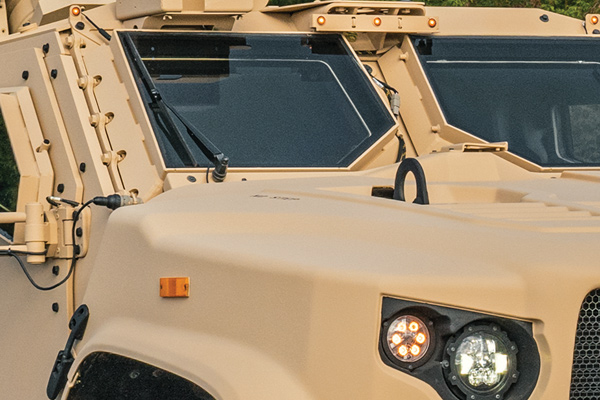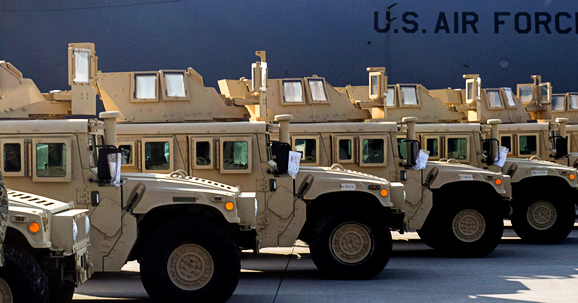CARC was introduced in the early 1980s by the United States Army. This protective coating system dealt with many federal and local examinations and assessments. Passing those examinations, CARC meets the three primary principles of US Army ideology:
- Endurance and Persistence
- Durability
- Environmental Observance
While mandating the use of Chemical Agent Resistant Coating (CARC) on all tactical vehicles and equipment, the army faced additional restrictions. Those restrictions included environmental regulations, like the approved maximum level of Hazardous Air Pollutants (HAP), while applying CARC to relevant components.
As omitting CARC results in a drastic compromise of military preparedness, consequently leading to potential perilous outcomes. Achieving both environmental compliance while maintaining its end purpose required continued developing technology.
CARC: More Than Camouflage
 CARC is the name for the specially developed, durable, non-absorbent, and highly resisting paint with a myriad of benefits. It is commonly applied to military vehicles and equipment, making the outside surfaces persevere despite the harsh and relentless environment.
CARC is the name for the specially developed, durable, non-absorbent, and highly resisting paint with a myriad of benefits. It is commonly applied to military vehicles and equipment, making the outside surfaces persevere despite the harsh and relentless environment.
Increased protection against chemicals and detection, CARC also provides the appropriate selection of color for visual appeal and uniform appearance. It suits the military in two ways:
- Providing a first-class camouflaging coating intended to disguise military vehicles and equipment from the enemy.
- Keeping the biological, chemical, and radioactive menace from penetrating the surface, thus increasing protection to higher levels.
Chemical Agent Resistant Coating's potential promised to keep the vehicle's and equipment's durability for a long time. This increased durability reduces the need for frequent maintenance and repairs and cutting additional costs.
CARC Colors
The base color is green, specifically Green-383. In the color's core is a pigment imitating the photosynthetic pigment found in plants: chlorophyll. This component absorbs a significant extent of red in the electromagnetic spectrum, making it almost impossible to detect by infrared reflectivity.
After its development in the early 1970s, they mixed Green-383 with newly formulated color Tan-686. It helped reduce the level of solar heat absorption in vehicles while operating in environments with higher temperatures.
Both Green-383 and Tan-686A became standard while increasing the reflectance characteristics of the coating. The different parts of CARC topcoat is:
- 44% primary pigments
- 24% adhesive
- 30% solvent
- 2% extra supplements
Nowadays, it is more wear-resistant and environmental-friendly than the coatings of the past.
Environmental Factors
 Only 3.3% of solar radiation on Earth is within the wavelength of 295-385 mm and stands for the ultraviolet radiant energy. Despite being the smaller part, it owns sufficient energy to influence chemical bonds.
Only 3.3% of solar radiation on Earth is within the wavelength of 295-385 mm and stands for the ultraviolet radiant energy. Despite being the smaller part, it owns sufficient energy to influence chemical bonds.
Although there is usually a discussion on CARC's influence on environmental quality, we cannot ignore the conversation.
Accelerated weathering is a testing methods establishing the degree the newly developed pigments cope with weathering exposures such as solar radiation, temperature, and humidity. The results provide information on long-term performance, colorfastness, and chemical integrity.
During testing, color topcoats were exposed to the direct-beam UV radiance. Results include depicting color change (loss or fade), level of degradation (corrosion or chemical bond breaking) with the total hours of exposure.
Compared with the past coatings, today's performance of CARC topcoats subjected to irradiance is significantly improved.
There has been increased effort into research and development of creating superior CARC coatings. The goal of these efforts are threefold:
- Satisfying Regulations and Standards
- Optimal levels of critical environmental protection
- Durable Surface Resistance.
The issues raised with CARC's usage raises continuous debate. One side emphasizes environmental safety and health—the other side pointing out the importance of civilian protection and social welfare.
There are many safety precautions listed for individuals in contact and using CARC, from how it applies to special safety gear and equipment. The principal aim is minimizing exposure and eliminating potential consequences.
Further research and development
 R&D has developed coatings with enough coverage fulfilling its mission without being a hazardous material. But there is still a space for making it friendlier. CARC coatings are considered toxic and volatile. Without proper care and management, the coatings severely impact the entire ecosystem.
R&D has developed coatings with enough coverage fulfilling its mission without being a hazardous material. But there is still a space for making it friendlier. CARC coatings are considered toxic and volatile. Without proper care and management, the coatings severely impact the entire ecosystem.
Still, because of its history, quality, and safety record, there is room for improvement. It's a tricky balancing act, reducing environmental impact while maintaining its strategic benefits.